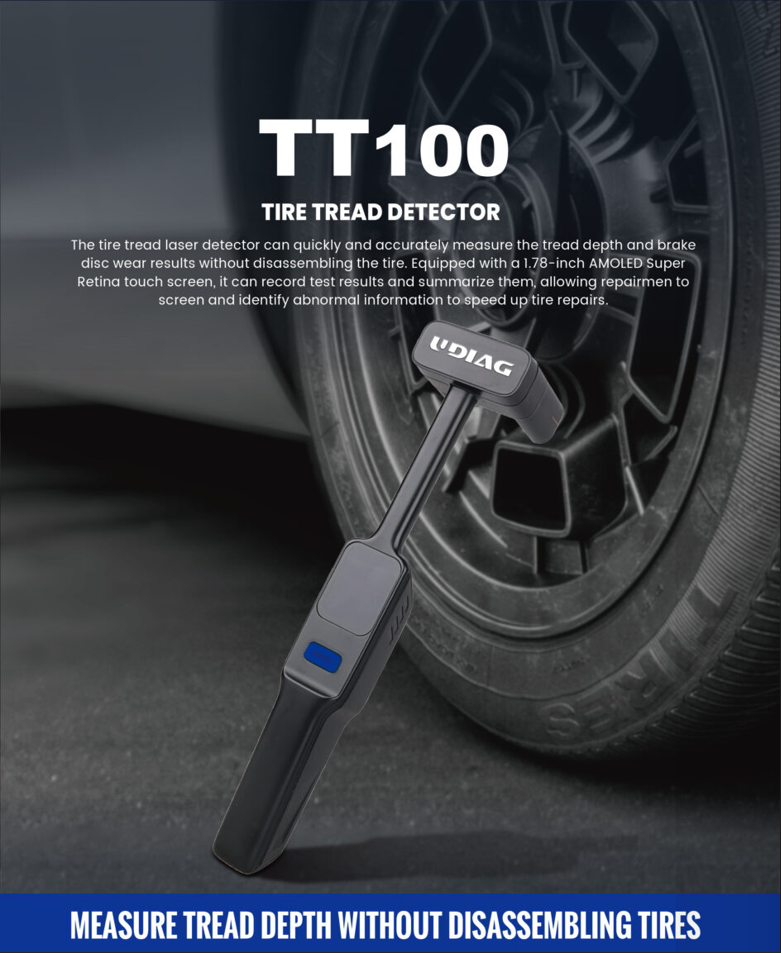The Role of Tire Tread Detectors in Autonomous Vehicles
2024-03-18 by UDIAG
Autonomous vehicles (AVs) are revolutionizing the automotive industry, promising safer and more efficient transportation. Central to the safety of AVs is the condition of their tires, with tire tread playing a crucial role in vehicle performance. In this essay, we explore the significance of tire tread detectors in AVs, examining their importance, technologies, challenges, applications, and future prospects.
I. Understanding Tire Tread Detection
Tire tread detection refers to the process of assessing the condition of a tire’s tread pattern. Traditionally, this has been done through visual inspection or manual measurements. However, with the advent of AV technology, tire tread detectors have emerged as a vital component for ensuring vehicle safety and performance. These detectors utilize various technologies such as visual inspection systems, laser-based systems, and sensor-based systems to assess tire tread depth and condition accurately.
II. Importance of Tire Tread Detection in Autonomous Vehicles
The importance of tire tread detection in AVs cannot be overstated. Firstly, it significantly contributes to vehicle safety by ensuring optimal traction, handling, and braking performance. A worn-out tire tread can compromise these critical aspects, leading to increased accident risks. Secondly, tire tread detection enables predictive maintenance, allowing early detection of tire wear and tear and preventing potential tire blowouts and accidents. Lastly, it plays a role in reducing the environmental footprint of AVs by minimizing tire wear and subsequent pollution.
III. Tire Tread Detection Technologies
Several technologies are employed in tire tread detection systems. Visual inspection systems utilize cameras to capture images of tire treads, while laser-based systems use laser beams to measure tread depth accurately. Sensor-based systems employ various sensors to detect changes in tire tread patterns. Each technology has its advantages and limitations, necessitating careful consideration based on factors such as accuracy, cost-effectiveness, and integration with AV systems.
IV. Challenges and Limitations
Despite their importance, tire tread detectors in AVs face several challenges. Environmental factors such as weather conditions and road surfaces can affect detection accuracy. Technological limitations, such as accuracy at high speeds and compatibility with different tire types, also pose challenges. Furthermore, regulatory and standardization hurdles hinder the widespread adoption of tire tread detection systems in AVs.
V. Case Studies and Applications
Numerous AV manufacturers have integrated tire tread detectors into their vehicles to enhance safety and performance. Real-world examples showcase the effectiveness of these systems in improving vehicle maintenance and reducing accidents. Additionally, tire tread detection technology holds promise for applications beyond AVs, such as in commercial fleets and transportation infrastructure.
Future Directions and Conclusion
The future of tire tread detection in AVs looks promising, with advancements in technology expected to address current challenges and limitations. Integration with other AV systems, such as collision avoidance and predictive maintenance, will further enhance vehicle safety and efficiency. In conclusion, tire tread detectors are indispensable for ensuring the safety, performance, and sustainability of autonomous vehicles in the years to come. Their continued development and integration will play a crucial role in shaping the future of transportation.
FAQs
1. Can tire tread detectors accurately assess tire conditions?
Tire tread detectors utilize advanced technology and algorithms to provide accurate assessments of tire conditions. By combining multiple sensing techniques, these detectors can precisely measure tread depth and identify potential issues with tire performance.
2. Do tire tread detectors require regular calibration or maintenance?
While tire tread detectors are designed to operate reliably under various conditions, periodic calibration and maintenance may be necessary to ensure optimal performance. Regular inspections and adjustments can help maintain accuracy and reliability over time.
3. Are tire tread detectors susceptible to interference from external factors?
Like any sensor system, tire tread detectors may be susceptible to interference from external factors such as dirt, debris, or adverse weather conditions. However, advanced design features and protective measures help minimize the impact of these factors on detector performance.
4. Can tire tread detectors detect potential tire failures before they occur?
By continuously monitoring tire conditions and detecting abnormalities in tread patterns, tire tread detectors can alert drivers and autonomous systems to potential tire failures before they occur. This early warning system enables proactive maintenance and helps prevent accidents on the road.
5. How do tire tread detectors contribute to overall vehicle performance?
Tire tread detectors play a crucial role in optimizing vehicle performance by ensuring optimal traction and efficiency. By providing real-time data on tire conditions, these detectors enable vehicles to adapt to changing road surfaces and maximize fuel efficiency, ultimately enhancing overall performance and reliability.
6. Are tire tread detectors compatible with all types of tires?
Tire tread detectors are designed to be compatible with a wide range of tire types and sizes, making them suitable for use in various vehicle applications. Whether it’s passenger cars, commercial trucks, or off-road vehicles, tire tread detectors can provide valuable insights into tire performance and safety.



